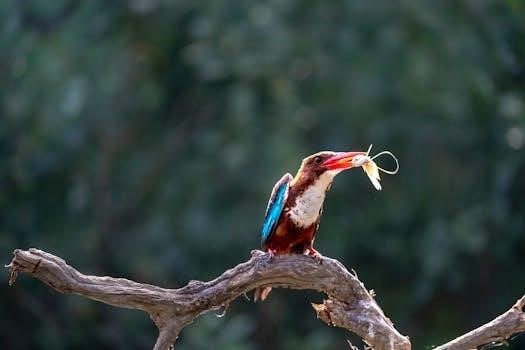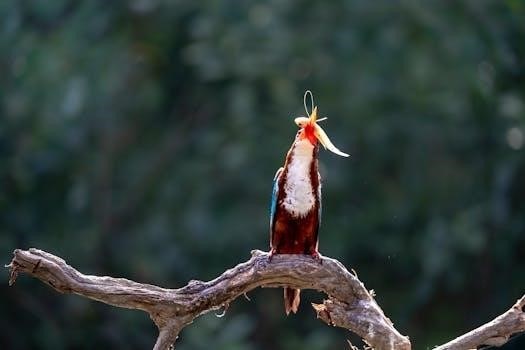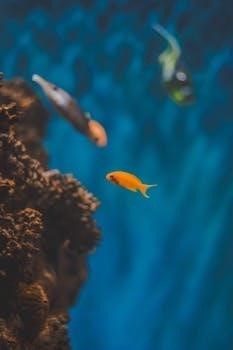inner fish pdf

‘Your Inner Fish’ explores the deep history of the human body‚ linking our anatomy to ancient fish. Neil Shubin‚ the author‚ details the evolutionary journey through fossils and DNA‚ revealing connections to creatures that lived millions of years ago. This book shows how the human body was assembled over time.
Overview of the Book
‘Your Inner Fish⁚ A Journey Into the 3.5-Billion-Year History of the Human Body’ is a captivating exploration of our evolutionary past. The book‚ penned by Neil Shubin‚ takes readers on a scientific adventure‚ tracing the origins of human anatomy back to ancient fish. It delves into the fascinating connections between our bodies and the creatures that came before us‚ revealing how our limbs‚ necks‚ and even our lungs have roots in the distant past. Shubin masterfully weaves together paleontology‚ anatomy‚ and genetics to paint a vivid picture of our evolutionary history. The narrative follows Shubin’s personal journey‚ including his expeditions to the Arctic Circle in search of pivotal fossils.
The book highlights how scientists utilize fossils‚ DNA‚ and biological processes to trace the development of organs and systems from early life forms to humans. It emphasizes the importance of understanding our evolutionary heritage. It also shows how seemingly disparate creatures are interconnected‚ showing a common lineage. The book emphasizes key discoveries‚ such as the Tiktaalik fossil‚ which bridges the gap between fish and land-dwelling animals. Ultimately‚ the book showcases the deep history of the human body and its connection to the natural world.
Author Neil Shubin’s Background
Neil Shubin is a renowned paleontologist and professor of anatomy‚ celebrated for his work on evolutionary biology. His academic background and passion for fossils have led him to make ground-breaking discoveries. He is notably known as one of the co-discoverers of Tiktaalik‚ a pivotal fossil that represents a crucial transitional form between fish and tetrapods. Shubin’s research focuses on the intersection of paleontology‚ developmental biology‚ and comparative anatomy. He expertly connects ancient fossils with modern understanding of human anatomy.
His scientific pursuits have taken him to remote regions of the world‚ including the Arctic‚ where he searches for fossils that shed light on the history of life. Shubin’s work is not confined to academia‚ as he also has a talent for communicating complex scientific ideas to a broader audience. He is the author of several popular science books‚ including ‘The Universe Within‚’ and the best-selling ‘Your Inner Fish‚’ which have garnered widespread acclaim. His expertise is in evolutionary theory and his ability to explain the science in an accessible way. His work has made significant contributions to our understanding of the human body.

Key Concepts in ‘Inner Fish’
The book explores the link between fish and humans‚ highlighting the discovery of Tiktaalik‚ a transitional fossil. It connects human anatomy to that of fish‚ and outlines the evolutionary journey of the human body‚ from ancient aquatic creatures.
The Discovery of Tiktaalik
The discovery of Tiktaalik‚ a pivotal moment in understanding the transition from water to land‚ is a central theme in “Your Inner Fish.” Neil Shubin’s exploration for fossils in the Arctic Circle led to the unearthing of this remarkable creature‚ a 375-million-year-old fossil fish that had both fish-like and tetrapod-like features. This find was significant because Tiktaalik had a fin structure with bones that corresponded to the bones in a tetrapod’s limb‚ suggesting a direct evolutionary link between fish and four-legged land animals. The fossil had a flat head and a neck‚ further confirming its status as a transitional form. The discovery of Tiktaalik dramatically reframed scientific understanding of the evolutionary process that led to the emergence of land-dwelling vertebrates from fish. The fossil is a key piece of evidence for the concept of common ancestry and demonstrates how the human body retains vestiges of its ancient origins.
Connecting Human Anatomy to Fish
“Your Inner Fish” establishes a profound connection between human anatomy and that of ancient fish‚ illustrating how our bodies retain traces of our aquatic past. The book emphasizes that many fundamental structures in the human body‚ such as our limbs‚ necks‚ and even certain aspects of our skulls‚ have their origins in fish anatomy. Through the examination of fossils like Tiktaalik‚ Neil Shubin demonstrates that the basic pattern of bones in our arms and legs is remarkably similar to that of ancient fish fins. The book also highlights the role of shared genes in the development of these structures across different species‚ revealing how evolution has repurposed and modified existing anatomical traits. This connection is not just about bone structure; the book also delves into shared developmental processes and genetic mechanisms that underscore a deep‚ interconnected evolutionary history between fish and humans. Understanding these links underscores the concept of common ancestry.
Evolutionary Journey of the Human Body
The book “Your Inner Fish” meticulously traces the evolutionary journey of the human body‚ starting from our ancient fish ancestors. It outlines how the basic blueprint of our bodies‚ including the skeletal structure and organ systems‚ evolved over millions of years through a series of incremental changes. The narrative details how fish fins gradually transformed into limbs capable of supporting movement on land. Shubin explains how the transition from water to land environments necessitated significant adaptations in breathing‚ circulation‚ and sensory perception. The book reveals how these adaptations‚ passed down through generations‚ have shaped the human form we know today. It illustrates how different parts of our body‚ such as our hands‚ necks‚ and lungs‚ can be traced back to these early evolutionary innovations. This detailed account highlights the continuous process of adaptation and modification that has shaped human anatomy‚ making our body a living testament to our evolutionary past.

Detailed Analysis
The detailed analysis delves into specific chapters‚ starting with the discovery of a fish fin fossil containing a shoulder bone structure. This section examines the significance of fossils in understanding evolutionary links and the gradual transformation of anatomy over time.
Chapter 1⁚ The Discovery of the Fish Fin
Chapter 1 of ‘Your Inner Fish’ unfolds in the 1990s‚ marking a pivotal moment in Neil Shubin’s career with his discovery of an ancient fish fin fossil. This find was not just another fossil; it possessed a structure that remarkably resembled a shoulder bone‚ an anomaly that piqued Shubin’s interest. The chapter highlights the initial stages of the investigation‚ focusing on the unexpected similarities between this ancient fish and the bone structures of land animals‚ including humans. Shubin’s curiosity is sparked by the realization that this particular fish fin fossil has the potential to rewrite the narrative of evolutionary biology. The narrative details the meticulous process of uncovering this fossil and the initial steps taken to understand its significance. The discovery sets the stage for a journey into the deeper connections between our own bodies and those of our distant aquatic ancestors. It explores the implications of this find‚ as it challenged preconceived notions and offered a new perspective on the history of life on Earth‚ and the evolution of our own bodies‚ linking us to the fish that swam in ancient seas.
The Significance of Fossils
Fossils‚ as explored in ‘Your Inner Fish’‚ are not merely ancient stones; they are vital time capsules that offer invaluable insights into the history of life on Earth. These preserved remains provide tangible evidence of the evolutionary journey‚ allowing scientists like Neil Shubin to piece together the story of how life forms have changed over millions of years. The book highlights the role of fossils in connecting seemingly disparate species‚ like the ancient fish and humans‚ revealing shared ancestry and anatomical similarities. By studying fossils‚ we can trace the development of key features‚ such as limbs‚ necks‚ and lungs‚ from their early aquatic origins to their present-day forms. The significance of fossils lies in their ability to bridge the gaps in our understanding of evolution‚ offering concrete proof of the transitional stages that led to the diversity of life we see today. They provide a window into the past‚ allowing us to see the evolutionary steps that have shaped us. The detailed analysis of fossils enables scientists to uncover the links between different organisms and reveal the interconnected web of life.

Relevance and Impact

‘Your Inner Fish’ significantly impacts our understanding of human evolution‚ showcasing the methods scientists use to uncover our past. It reveals the deep connections between humans and other species‚ emphasizing our place in the grand scheme of life.
Understanding Human Evolution
‘Your Inner Fish’ provides a profound look into human evolution‚ illustrating how our bodies are a mosaic of features inherited from ancient ancestors. Neil Shubin’s work connects our limbs‚ necks‚ and even our lungs to fish that transitioned to land millions of years ago. The book demonstrates that through studying fossils‚ DNA‚ and development‚ scientists can trace the lineage of human traits back through time. The discovery of Tiktaalik‚ a fish with limb-like fins‚ serves as a powerful example of this transitional form. By understanding this journey‚ we gain a clearer perspective on our place in the history of life on Earth. This book reveals that human evolution is not a straight path but rather a complex series of adaptations that have built our current form. It highlights the shared ancestry with many species‚ including fish‚ and emphasizes that the human body is not a unique creation. The book also explains how a genetic recipe has developed over billions of years and how that recipe shapes the biological processes inside us. Shubin’s research shows that our biological inheritance is not as novel as we imagine.
Scientific Methods and Discovery
‘Inner Fish’ beautifully illustrates the scientific method in action‚ showcasing how paleontologists like Neil Shubin use fossil evidence to piece together the history of life. The book details the meticulous process of fossil hunting‚ including expeditions to remote locations‚ the careful excavation of specimens‚ and the analysis of their anatomical structures. Shubin also explains how scientists use comparative anatomy‚ genetics‚ and developmental biology to understand the relationships between different species. The book highlights how the discovery of Tiktaalik was not a chance event but rather the result of a deliberate search based on scientific predictions. It showcases the collaborative nature of scientific research and the importance of multidisciplinary approaches in unraveling complex biological questions. This book exemplifies how scientific discovery is often the result of persistence‚ careful observation‚ and a willingness to challenge existing ideas. Through his journey‚ Shubin shows the process of scientific inquiry‚ from the initial question to the final answer. It also demonstrates the need for scientific analysis and the importance of interpreting data to arrive at conclusions.
The Broader Implications of ‘Inner Fish’
‘Inner Fish’ has profound implications that extend far beyond the realm of paleontology. It demonstrates that humans are not separate from the rest of the natural world but rather are a product of a long evolutionary history shared with other organisms‚ including fish. This understanding fosters a deeper appreciation for the interconnectedness of life and our place within it. The book also serves to demystify the process of scientific discovery‚ making the complex ideas of evolution accessible to a wider audience. By revealing the ancient origins of our bodies‚ ‘Inner Fish’ challenges anthropocentric views and encourages us to consider our place in the larger scheme of things. The book also underscores the importance of scientific literacy in a world increasingly shaped by technological advancements. It encourages a curiosity about the natural world and an appreciation for the processes that have shaped life on Earth. Furthermore‚ it presents a compelling argument for the continued study of fossils and genetics to further understand our past‚ present‚ and future. Ultimately‚ the book fosters a sense of wonder and respect for the intricate history of life on our planet.